by Winding Pathways | Sep 2, 2021 | (Sub)Urban Homesteading, Birds, Nature
A flurry of movement caught our attention. Just outside the dining room window, a tiny scrap of a bird flitted around. It wasn’t a wren, goldfinch, or sparrow. They’re around all year. Just what was it?
For most birders, May is the month to live for. Orioles, grosbeaks, tanagers, and warblers arrive as if by magic. They’re colorful, sing with gusto, and are easy to spot. It’s an exciting time, but it’s not THE ONLY exciting time.
All the colorful migrating May birds en route to northern nesting sites and the ones that stick around to nest locally are now heading south to avoid winter’s harshness. September is an outstanding birding month, but it’s also challenging.
September Birding
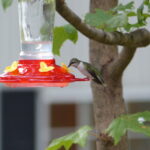
Birds stock up on high-calorie foods before their long migrations.
The birds are there but easy to miss. Many have gone through a late summer molt. They’ve replaced gaudy spring feathers with drab ones that enable them to hide better. September is a business month for birds. In May they happily court mates, but four months later the priority is beefing up their bodies for the long flight south. They dart about, often out of sight, seeking tasty insects, spiders, and seeds to fuel migration.
September birding takes patience. We find the most effective way to see birds is to sit quietly and watch. While we may slowly walk trails spotting birds in May, by September we sit on our deck in comfortable chairs, binoculars handy, and bird books and apps at the ready. We don’t find the birds. They find us, but because they don’t sing much and often look different than in Spring, identification is challenging.
Our backyard birding is exciting because we’ve diversified vegetation and have brushy areas, a prairie, a small pond, and big trees close by. However, we don’t just look there for birds. Sometimes we look upward to see soaring nighthawks, migrating raptors, and an occasional skein of Canada geese.
-
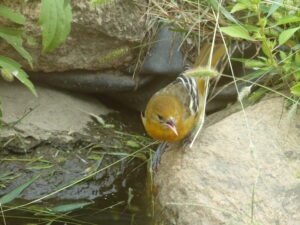
-
Birds stop for a drink and to fill up on the berries nearby.
-
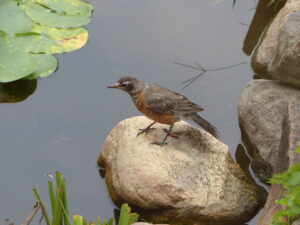
-
Keeping a wary eye, the robin cautiously gets a drink.
Identifying Fall Birds
To help with identification we use several printed bird books including the Peterson Guide and David Allen Sibley’s books. Increasingly we rely on Merlin. It’s an outstanding app produced by the Cornell University Laboratory of Ornithology. Even better, it’s free. The app easily helps identify species and shows many photos of every bird in spring/fall/juvenile/gender plumages. It also has range maps and recordings of the birds’ calls and songs. Merlin recently added a new function: sound identification. Point the phone at a singing bird and the app will help identify it by sound.
After we tentatively identify a bird, we try to confirm it by an Internet search and by consulting our birding friends. Our definitive online source is the Lab of Ornithology’s website. The site contains a vast amount of information, including how to access and use Merlin and eBird.
Easy to Keep Records
eBird allows us to record all bird species we spot in a day. Then we email results to the Lab for analysis. It’s great fun and helps the Lab research bird populations and movement.
There’s more to fall than football and leaf raking. It’s an excellent time to bird and the best birding is often the backyard.
by Winding Pathways | Aug 19, 2021 | (Sub)Urban Homesteading, Amphibians/Reptiles, Garden/Yard
Outside our dining room is a tiny pond crafted by our home’s previous owner. It’s smaller than a compact car and is the regular home of water lilies, dragonflies, and a few goldfish we stock to eat mosquito larvae. One morning we were astonished to spot a large frog partly submerged on the pond’s edge. Where did it come from and how did it get here?
We live on an ancient sand dune. Rain quickly percolates downward, so the rubber membrane at the pond’s bottom holds water that would otherwise quickly disappear. No other bodies of water are close by. Could our frog have hopped a half-mile uphill from Indian Creek? Did it come from a nearby neighbor’s pond? And, how would it have got there since we all live on a hill?
We know birds, insects and mammals find and settle in new habitats. They’re mobile and fly or walk until they spot a new home place. Frogs and turtles can walk – or hop -but they’re slow and vulnerable to predators when venturing on land.
Ask the Expert!
We didn’t know how our frog found our pond, so we asked biologist Dr. Neil Bernstein.
He responded by saying that some frogs disperse from wetland to wetland randomly, and there’s speculation that eggs can attach to waterfowl legs. His short answer was, “I don’t know”.
That’s a wise response. Science has revealed many of nature’s mysteries, but more remain unknown. Did our frog somehow sense that a tiny pond way up yonder would be a good place to risk hopping to? We don’t know but we’re certain this wandering amphibian is welcome to enjoy life at Winding Pathways.
-
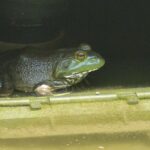
-
Waiting for lunch in the shade.
-
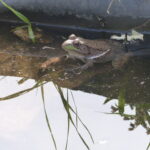
-
How the frog came here is a mystery.
-
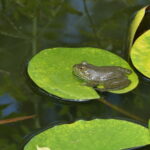
-
Resting in the sun.
-
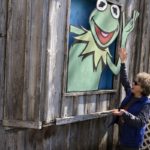
-
Leland, Mississippi is home of Kermit the Frog.
by Winding Pathways | Aug 12, 2021 | (Sub)Urban Homesteading
We’re of an age when every few years our doctor prescribes a colonoscopy. It’s not something to look forward to, but it makes perfect sense. Early detection catches cancer while there’s time to take effective medical action.
The same goes for wood stoves. Wood is our main heating fuel, and we burn several cords each winter. To keep our home safe, we hire Midtown Chimney Sweeps each June to remove soot from our chimney and do a stove and flue safety check.
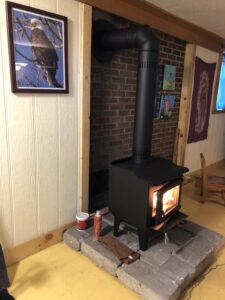
Maintaining a woodstove is like getting a periodic colonoscopy.
Burning wood can cause two types of chimney deposits. Burning unseasoned wood or restricting air coming into the stove can create a dangerous buildup of creosote. Too much creosote and soot in the chimney are a recipe for a chimney fire. They’re scary and cause homes to burn down and endanger lives.
We prevent this by burning only dry wood and burning at a fairly high stove air intake. These steps prevent the fire from smoldering all night and avoid creosote buildup. We let our fire die out in the late evening and restart it the next morning.
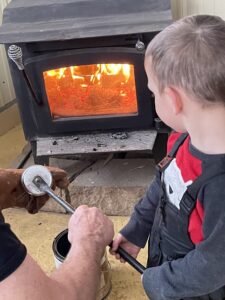
Learning to respect the woodstove.
We’ve never had a creosote buildup, but soot does lodge in our chimney. Midtown removes it early each summer so we’re ready to light the stove on autumn’s first crisp evening.
A colonoscopy reduces the odds of dying of colon cancer. Stove and chimney cleaning reduce the odds of a serious house fire. Both are smart to do.
-
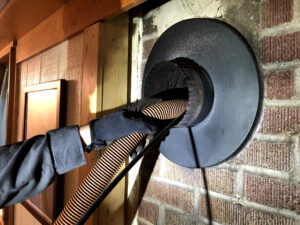
-
Midtown is careful to reduce dust as the workers clean the chimney.
-

-
The workers are prompt, thorough, friendly.
Note: Many companies do excellent work cleaning chimneys. We were not paid by Midtown Chimney Sweeps to mention their company in this blog. They simply have always done good work at our home. We encourage anyone who uses a wood stove or fireplace to keep it in good working condition and have it and the chimney cleaned regularly.
by Winding Pathways | Aug 5, 2021 | (Sub)Urban Homesteading, Garden/Yard, Nature
When we moved to our home in 2010, we immediately began changing the landscaping. The former owner had mowed nearly our entire two acres. It was clipped, manicured, and lacking in diversity. The soil was sand, rock hard, or dense clay. From this sterile, unnatural yard we created a wondrous landscape rich in plant and animal life.
Over the years we removed exotic ornamental trees and replaced the mowed lawn with native prairie. Now, 11 years later, our yard has transformed into more natural landscapes filled with colorful and fascinating wildlife and plants.
In the early years, one thing puzzled us. No earthworms. If we wanted some for bait, we couldn’t find a single one. As the years moved forward, we began seeing a few worms, and then an abundance as they emerged after a light rain. What made the difference?
The Worm Dilemma
Worms are a dilemma for anyone wishing to favor native species. Common worm species are not native. Transported to the New World during early settlement days, they spread like crazy. Gardeners and farmers love worms for their diligent work softening, fertilizing, and aerating the soil. They are great for gardens but cause ecological damage in forests that evolved without them.
Mostly we like worms. They’re an indicator of soil fertility and health and make our gardens more productive. But, why didn’t we have many in the early years of our ownership?
We suspect the former owner did more than mow. He doused the land with artificial fertilizer and pesticides and suppressed plant diversity. Both made life difficult for worms and other creatures.
It took a few years of composting and diversifying plant species but gradually we saw encouraging signs. More and different beneficial insects came to find dinner and a home in our yard. Worms returned with gusto.
We don’t manage our yard to be completely organic. When we spot a poison ivy sprig our small squirt bottle of herbicide takes care of it. Neither of us wants the awful cases of rash the plant caused us in years past. But, that’s about it. We use no insecticides and, except for the poison ivy killer, no herbicide.
Asian Jumping Worms
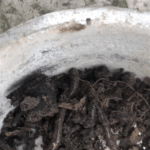
Asian Jumping Worms eat the leaf litter in forests that hold and break down into soil.
A few falls ago we brushed aside the garden mulch and were greeted by a few worms thrashing around at whirlwind speed. They were Asian jumping worms. New to Iowa they’ve been in many Eastern states for years. We easily identified them by their fast movement, white clitellum (the band around them), and their size. They’re just a bit smaller than a nightcrawler. These worms damage forests by eating the leaf layer that nurtures many native species and prevents erosion.
Our chickens dined on the Asian jumpers we tossed into their run, but we’re sure we’ll find more.
by Winding Pathways | Jul 22, 2021 | Nature, Wonderment
Winding Pathways borders 110-acre Faulkes Heritage Woods, a primeval woodland that changed dramatically in 40 minutes last August 10, 2020, when a derecho roared through Eastern Nebraska, all of Iowa and into Illinois.
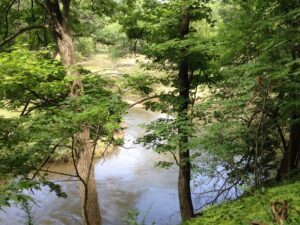
A short walk through the woods brought us to Indian Creek.
Prior to the storm, the view from our back deck was of towering oaks, hickories, walnuts, and a few maples. We’d often walk a quarter-mile to Indian Creek under a nearly closed crown of intertwined branches far overhead.
Then a derecho roared through with 140-mile-an-hour winds. (Watch several videos of the storm)
When we ventured outside, we found two big trees on our garage and cabin, and most of our own trees prostrated. Our power and Internet were down. Our biggest shock was the woods. Instead of immense giants, we saw trees that had withstood 150 years of wind shattered. Some were uprooted. Many snapped off with their trunks standing like poles. Others were twisted apart by the powerful wind.
It was devastating. Heartbreaking. All winter our view was of broken trees………until spring’s warmth worked magic on the woods.
-
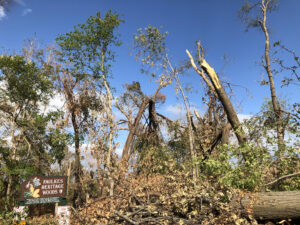
-
Faulkes Woods is still a tangle of jackstraw trees.
-
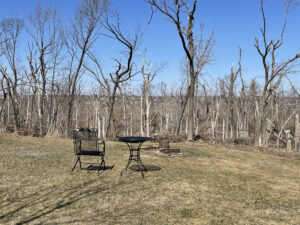
-
All winter we looked on broken trees.
-
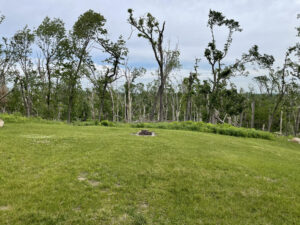
-
Springing Back from Derecho.
Forests are resilient. For the first April in over a century sunlight reached the forest floor. As it gained strength in May and June it triggered a resurgence of vegetation we’d never seen in the woods before. All were plants that can’t thrive in dense shade.
We were overjoyed to see tree sprouts. Baby oaks, hackberries, ironwood, maple, and basswoods popped up here and there. Soon they were joined by a thick growth of what many would call weeds. A few are new to us, including oakleaf goosefoot. Some are concerning. The sunshine is encouraging invasive garlic mustard, multiflora rose, and Japanese barberry, but we also spotted something delicious.
Long dormant raspberry and blackberry canes rose from the soil. We’ll enjoy a great berry harvest next summer and for many following years until new trees gradually shade them to dormancy.
-
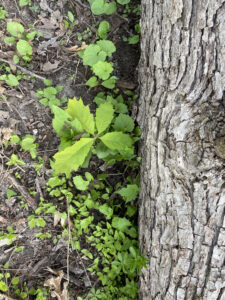
-
The seedling radiated hope.
-
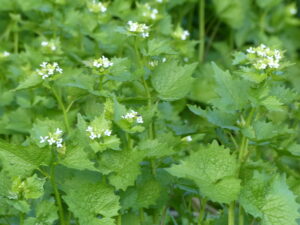
-
Invasive plants take advantage of change.
-
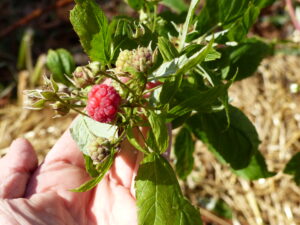
-
Miracle in the rubble
Nature is resilient, and we’re watching a woodland resurrection from our back deck.
-
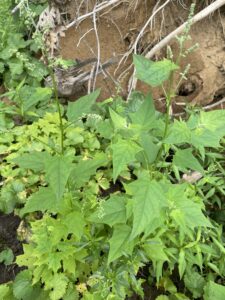
-
This sun lover is nestled close to the uprooted log.
-
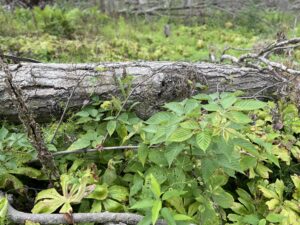
-
Sun loving brambles surround fallen log.
Watch a video from 12th Ave. Bridge in Cedar Rapids.





















